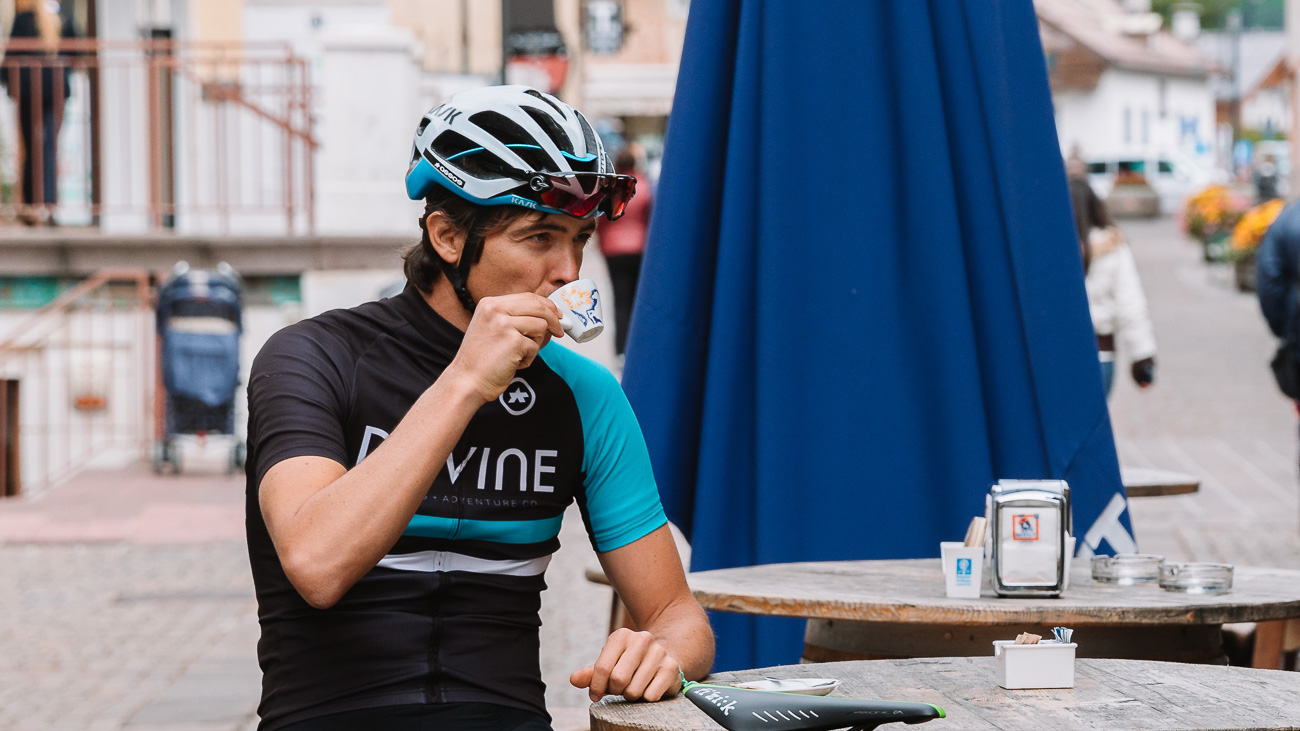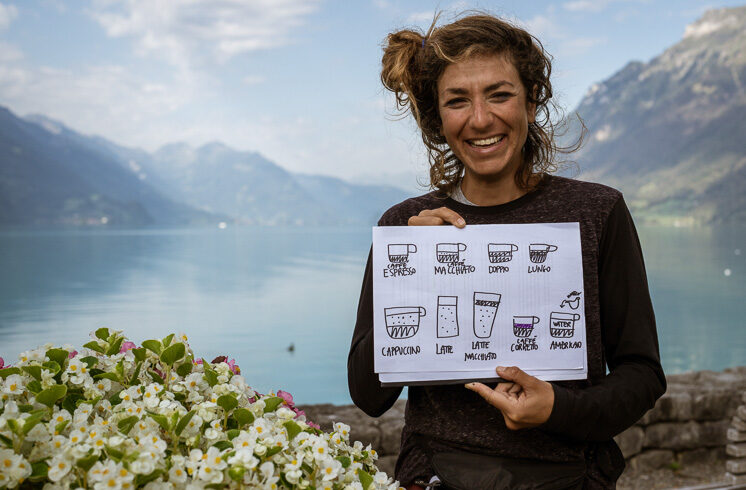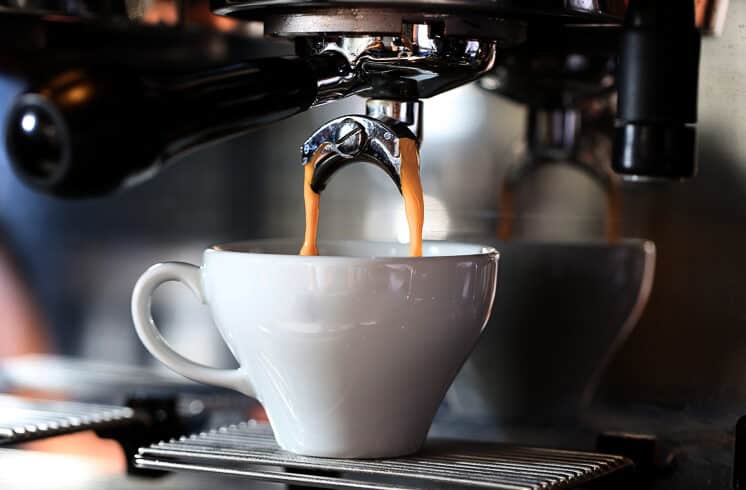While wine might be the beverage at the center of many DuVine trips, no European bike tour is complete without our quintessential mid-ride coffee stop. Whether you’re sipping a café au lait on a sunny French terrace or chatting with locals in a cozy Portuguese café, coffee culture in Europe is intrinsic to the DuVine experience.
Don’t worry, though—you don’t have to be a coffee connoisseur to enjoy it. Our local guides will always be there to order on your behalf, but with a little pre-arrival awareness, ordering coffee in France, Italy, Spain, and Portugal can be a cross-cultural achievement. We’ll prepare you to sip your way through some of the rich traditions and unique customs of European coffee culture.

Portugal
If you’re joining DuVine on a trip to Portugal, get ready to embark on a journey of unique terminology and coffee-centered customs practiced by the Portuguese.
For your caffeine fix, head to a pastelaria or café—the two most common places to enjoy a coffee. These shops are neighborhood gathering spots for socializing and sipping a cup, two daily rituals the Portuguese take very seriously. Pastelarias are distinct from cafés, offering cakes, pastries, and sometimes even alcohol—it’s not uncommon to see relaxed regulars and local folks sipping on brandy or beer here in the afternoons. Seat yourself at a table and wait for a server or follow the lead of the local patrons and head straight to the counter to order.


Second only to vino, coffee is the social drink of choice in Portugal, so it’s typical to drink several throughout the day with friends and colleagues. Locals like their coffee like they like their wines: full-bodied and robust, so the typical Portuguese café order is um café, meaning a shot of espresso. While asking for um café is perfectly correct, there are regional variations of this common order. In Lisbon, a shot of espresso is um bica, and in Porto, um cimbalino.
Need a stronger jolt of caffeine? Ask for a cheio, which is an elongated espresso filled to the top of the cup. If you’re in the mood for an americano, order an abatanado, a double espresso with hot water. And for those who like their coffee with milk, order um galão, which is the closest thing to an American latte.

France
Ubiquitous to the French way of life, coffee is a cornerstone of French culture. As we pedal through the Loire Valley and the vineyards of Burgundy, we’ll pause in charming villages where coffee is served almost everywhere you look.
Once you’ve greeted the barista with a convivial “bonjour,” post up at the counter for a quick espresso by asking for un café. Keep in mind that if you order at the counter, you won’t be able to take your drink to a table—so if you have time to linger, wait for a server to escort you to a table. If you sit, note that the prices at the table can be twice as high as a cup at the counter, but we think the ambiance and French art of people-watching are worth the price of admission.
Do you take milk in your coffee? Set yourself up for a full day of riding with a creamy, steaming café au lait—strong black coffee to which steamed milk is added. Usually enjoyed during breakfast with a French pastry, café au lait is also a perfect mid-ride pick-me-up. A few other options for coffee with milk include a café crème, a combination of espresso and steamed milk topped with foam, or a café noisette (espresso with a touch of hot milk). To enjoy a coffee that resembles American-style drip coffee, order a café allongé, which is made by adding water to espresso.


Spain
The Spanish can’t start their day without coffee and generally enjoy their first cup at home before heading to the café midmorning to meet friends. So, take your time and do as the Spaniards do–head to a café in a public square where you can sit outside, mingle, and soak in the buzz of locals about their morning routines. As in Portugal and France, you can order a quick coffee at the bar or take a seat and be served.
With any coffee drink in Spain, be prepared for a more bitter flavor than what you might be used to. Many traditional cafés still use the torrefacto method of roasting, which involves burning sugar onto the beans for a distinctly bold flavor. For the purest example of this bold roast, order a solo corto (espresso) and your cadence on the bike will spike.
In general, coffee drinks in Spain are classified by the amount of milk they contain. All drinks start with espresso as the base: for something creamy, try a traditional café con leche, which is equal parts espresso and scalded milk. If you want to indulge in something lighter than a café con leche but less bold than a solo corto, order a cortado—an espresso cut with a splash of milk.
In Spain, coffee is often served in a glass, but you can still get your fix in a cup by ordering a taza. And good news for the iced coffee-obsessed: if you ask for your coffee of choice con hielo, your server will present you with a glass of ice that you can pour your hot coffee over.


Italy
Italians take their coffee seriously, and it’s a delicious adventure with its own unwritten rules and etiquette. Each of Italy’s regions may have its nuances, but a few general tips will help you order like a local in cafés from Piedmont to Puglia.
In Italy, the day is marked by coffee engagements often taken at a bar. Unlike our understanding of a bar in the U.S., a “bar” in Italy is a café that serves coffee drinks in addition to pastries, snacks, and alcohol, and remains open from morning to night. Bars are on every corner and in town squares, but we’ll show you the best bars loved by locals off the main streets.

Just like in France, you’ll pay more to sit and sip. To down a quick shot of espresso, head straight to al banca where you’ll be served to stand at the counter. Order and finish your coffee before paying at the register and be sure to carry small bills and coins—cash is favored at the till.
While Italians have coffee throughout the day, the morning is the only time they drink it with milk. For your first brew, order a classic cappuccino, caffè latte, or a latte macchiato (that’s espresso with just a dash of steamed milk) to pair with your breakfast pastry. Ordering a “latte” will result in a cup of plain, steamed milk, so make sure to use the correct names! After 11:00 am, it’s espresso only, and ordering anything but is a big no-no–or as the Italians say, passo falto.
In the afternoon (and especially after a meal), order an espresso, aka caffè. You can take your espresso ristretto (short) or lungo (long) depending on whether you like it pulled with more or less hot water.


Nothing fuels a bike ride better than a steaming cup. Whether you’re cycling through Douro Valley or stopping to refuel your ride in the the Italian Dolomites, one thing remains constant: coffee is a universal language, and an essential part of our trips—you never know what meaningful connections you might make over a hot cup of coffee.




